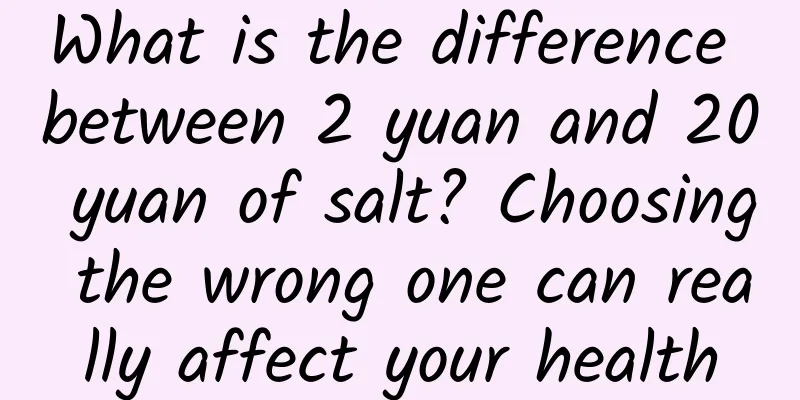What is the difference between 2 yuan and 20 yuan of salt? Choosing the wrong one can really affect your health

|
If there is one indispensable condiment in the kitchen, it must be salt. Without it, the dishes will become tasteless. But what is troubling is that there are too many types of salt on the market. All kinds of salt occupy a whole shelf, and the prices are also uneven. For example, sea salt, well salt, bamboo salt, lake salt, rose salt, calcium salt, selenium-rich salt... some are only two or three yuan a bag, and some are as high as dozens of yuan. What is the difference between them? Is the expensive salt more worth eating? Why do people need to eat salt? Eating salt is not only to make dishes more delicious, but also for good health, because the sodium ions in salt are an important participant in maintaining human life activities. Sodium has important functions such as regulating the volume and osmotic pressure of extracellular fluid in the human body, maintaining the acid-base balance of body fluids, maintaining normal blood pressure, and participating in the body's energy metabolism. Maintaining a certain concentration and appropriate proportion of sodium, potassium, calcium, magnesium and other ions in body fluids is necessary to maintain neuromuscular excitability, and the normal concentration of sodium is an important factor in ensuring this function. Copyrighted stock images, reprinting may cause copyright disputes Although sodium is widely present in food, except for some aquatic products, most other natural foods do not contain high levels of sodium. Therefore, it is difficult to meet the body's sodium needs by eating natural foods alone (the appropriate sodium intake is 1500 mg/day). Eating salt appropriately can help us supplement enough sodium. If the sodium provided by table salt is not taken in enough, it will affect the body's normal physiological functions and cause hyponatremia. Mild sodium deficiency can make people apathetic, tired, and listless. Slightly more serious cases can cause nausea, vomiting, low blood pressure, cramps, and even shock or death. Especially those who sweat a lot in hot jobs and heavy manual laborers, and patients with gastrointestinal diseases who vomit or have diarrhea repeatedly, should pay more attention to sodium supplementation. What are the differences between different salts? Now when you go to the supermarket to buy salt, you can see all kinds of salt. The originally simple act of "buying a bag of salt" instantly makes people have a fear of making choices. 1. Salt from different sources Mineral salt, lake salt, and sea salt, these salts only have different sources, but they are all sodium chloride in essence, there is not much difference. Well salt is made from rock salt or underground brine (excluding underground brine in coastal areas). Geologically speaking, the places with well salt were almost all sea in ancient times. After historical changes, under the scorching sun, strong wind and evaporation over the years, the sea water dried up, and salt continued to precipitate, forming layers of salt caps, which were later covered and buried by mud and sand, and buried underground with the violent movement of the earth's crust. Because it has been "isolated from the world" for too long, the sodium chloride has high purity and few impurities after processing, making it relatively pure. It is relatively common on the market, and the cheapest one is only 2 yuan per bag. Lake salt (pond salt) Lake salt is salt directly extracted from salt lakes and salt made from salt lake brine in salt fields. my country is one of the few countries in the world with extremely rich lake salt mineral resources. Lake salt particles are large and not easy to clump, so the product basically does not require the use of anti-caking agents. sea salt Edible sea salt is made from seawater or sea salt; sun-dried sea salt is edible sea salt made by processes such as sun-dried seawater concentration and crystallization; refined sea salt is made from seawater or sea salt, using vacuum evaporation salt-making technology, mechanical hot compression evaporation salt-making technology or crushing, washing and drying technology; snowflake sea salt is snowflake-shaped edible sea salt made from sea salt as raw material, through processes such as dissolution, filtration, evaporation, crystallization and drying. Jiangsu Yancheng Salt Fields丨Copyrighted pictures from the library; reprinting may lead to copyright disputes Sea salt is not easy to clump, and the product must not contain anti-caking agents, and no potassium ferrocyanide/sodium ferrocyanide is added. In addition, the purity of sodium chloride in sea salt is relatively low. 2. “High-end salt” on the market Bamboo salt and Himalayan rose salt give people a high-end feeling. Their essence is also to supplement sodium chloride, but the flavor and appearance are slightly different from ordinary salt. Bamboo Salt Ordinary bamboo salt is made of table salt, which is poured into a fresh bamboo tube once (or multiple times), sealed with loess, and fired at high temperature. Nine-baked melting bamboo salt is made of table salt, with or without the addition of food additive potassium chloride, which is poured into a fresh bamboo tube eight times, sealed with loess, and fired at high temperature, and melted at high temperature during the ninth firing. Bamboo salt is white, off-white or purple-brown, and has a salty taste as well as a fresh or preserved egg flavor. The price of a 250-gram bag of bamboo salt is usually between 7 and 10 yuan. Himalayan rose salt It is a type of rock salt, which is said to be mined near the Himalayas in Pakistan. Its natural pink color comes from the iron in it. It has a high appearance and a high price. The price of 250 grams is nearly 20 yuan. The iron content of this salt may be higher than the salt we usually eat, but don't expect it to supplement iron, as it generally does not contain iodine. Himalayan Rose Salt丨Copyrighted library pictures, reprinting may cause copyright disputes 3. Nutritionally fortified salt In addition to the iodized salt we eat daily, there are some salts that have been nutritionally fortified, such as calcium salt and selenium-rich salt, which leads many people to mistakenly believe that "eating such salt is more nutritious." The recommended intake of calcium and selenium for ordinary adults in my country is 800 mg/day and 60 μg/day respectively, and these "nutrient salts" have very little effect in nutritional supplementation. We eat salt mainly for seasoning and sodium supplementation. The Dietary Guidelines for Chinese Residents recommends that each person consume no more than 5 grams of salt per day. Based on this amount, one can only consume a maximum of 7.5 milligrams of calcium or 0.75 micrograms of selenium, which is far from the recommended amount and has little effect. If you eat a lot of salt just to get these so-called "nutrients", it will not be worth it! A brand of calcium salt A brand of selenium-rich salt Choose the right salt, not the expensive one For our average family, when buying salt, it is recommended that you pay attention to the sodium content and iodine content of the salt. 1. Low sodium salt Low-sodium salt uses a portion of potassium chloride instead of sodium chloride. The saltiness is almost the same as that of ordinary table salt, and cooking does not affect the taste. If you suffer from cardiovascular disease or high blood pressure, eating low-sodium salt can help lower your blood pressure. However, people who work in high temperatures, do heavy manual labor, some people with kidney disease, and patients with uremia should be cautious when eating low-sodium salt. 2. Iodized Salt Iodine is an essential trace element for the human body and an important raw material for synthesizing thyroid hormones. It can maintain human health. The main purpose of consuming iodized salt is to prevent goiter caused by iodine deficiency. A brand of iodized salt Most areas in my country are iodine-deficient areas, especially mountainous areas, hilly areas, river valleys, desertified areas and river erosion areas. In iodine-deficient areas, it is necessary to eat iodized salt. Even if you live in coastal areas, you need to eat iodized salt. Although foods such as kelp and seaweed in coastal areas are rich in iodine, if the local residents have a low frequency and consumption, they still need to eat iodized salt to supplement the recommended amount. However, it is recommended that residents living in areas with high iodine in water sources eat iodine-free salt. In addition, patients with hyperthyroidism and some thyroid tumors are also suitable for eating iodine-free salt. However, not all thyroid diseases require eating iodine-free salt. You should follow the doctor's advice according to your own situation. You can eat salt, but in limited amounts! Eating salt is necessary for maintaining health, but it does not mean the more you eat, the better. Both the World Health Organization and the Chinese Dietary Guidelines recommend that daily salt intake should be controlled to no more than 5 grams. 5 grams of scattered salt, the diameter is slightly larger than a 1 yuan coin | Photo by the author This is because the harm caused by a high-salt diet cannot be underestimated and will cause a series of health problems. Not only will it induce high blood pressure, it will also stimulate the body's inflammatory response, and even increase the risk of osteoporosis, stroke, and gastritis, and it may also affect cognitive ability. In addition to controlling salt intake, we should also pay attention to the invisible salt in our lives, such as soy sauce, oyster sauce, steamed fish soy sauce, soybean paste, miso, pickles, and kimchi. The method for calculating salt content is: sodium content in the nutrition information table (mg) ÷ 400 = salt content (g) There are many types of salt, and there is no need to pursue "high-end" and "nutritious". For most of us, we only need to choose low-sodium salt, iodized salt, etc. according to our personal needs. No matter what kind of salt you eat, you must control the salt intake and eat a light diet. References [1] Chinese Nutrition Society. Dietary Reference Intakes of Nutrients for Chinese Residents (2023 Edition) [M]. People's Medical Publishing House. 2023.8 [2] Zhuzhou Municipal Market Supervision Administration. Where does salt come from? How is salt made? [EB/OL]. (2021-07-02) [2024-4-29] http://scjgj.zhuzhou.gov.cn/c13764/20210707/i1723747.html [3]T/HBFIA 0022-2021 Edible Sea Salt[S].2021.06.28 [4]QB/T 5682-2022 Bamboo Salt[S]. 2022.04.08 [5] Chinese Society of Endemic Diseases, Chinese Nutrition Society, Chinese Society of Endocrinology. Guidelines for Iodine Supplementation for Chinese Residents[R]. 2018:5 Author: Xue Qingxin, registered nutritionist Review | Ruan Guangfeng, Deputy Director of Kexin Food and Health Information Exchange Center |
<<: Water celery or poison hemlock? Don't pick wild vegetables on the roadside
>>: Even the air is full of WiFi signals. How can we protect children’s eyes?
Recommend
APP Tips: Apple IOS/Android Market First Release Rules and Contacts
Every CP is confused and takes detours at the beg...
Tesla recalls 734 imported Model 3s due to risk of loose screws
According to the official website of the State Ad...
If you see these creatures on the beach, don't touch them!
Many people like to go to the beach for fishing o...
The most comprehensive case analysis of event planning and operation strategies
Today I’d like to talk to you about how to run a ...
Lanzhou shared power bank mini program has customized functions. How much does the shared power bank mini program cost?
With the advent of the 5G era, the network speed o...
How to write a hot note on Xiaohongshu?
Some time ago, in order to deeply experience the ...
Where to open the Kuaishou shopping cart?
This article mainly introduces the relevant infor...
Advice from 5 senior APP promoters to practitioners
In the process of acquiring APP users, the compet...
Why do some people look old and others look young? Here are 6 reasons...
Beautiful things are always fleeting, and beautif...
Le Xiaobao Story Optical Machine Disassembly Review
As the first parent-child smart toy product launc...
Internet advertising promotion planning methods!
What is planning? Planning is to simplify complex...
Android Studio template file group
The file group template is a powerful Android dev...
App promotion: 15 rogue promotion methods should be used with caution!
Rogue promotion methods are methods that some man...
In information flow advertising promotion, how to enable users to complete transactions quickly?
When users are unable to fully understand the pro...









